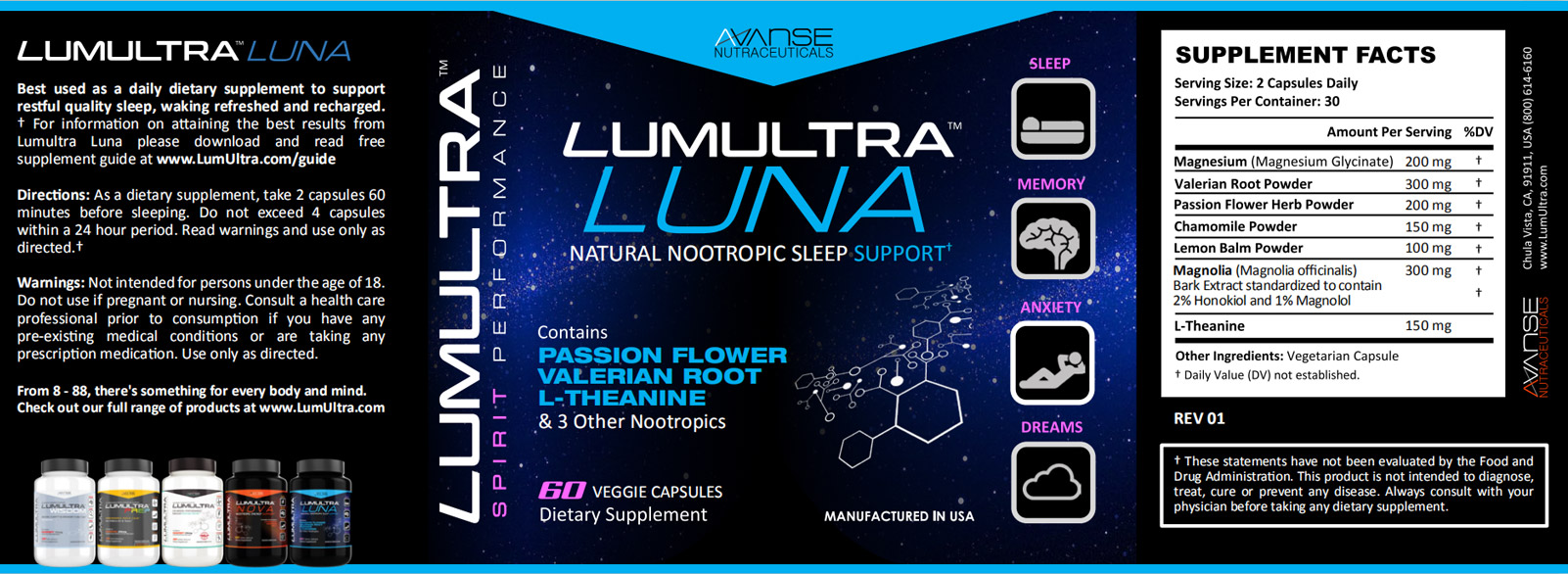
Table of Contents
- Better Sleep, Better Mood, Better Focus.
- What is Lumultra Luna?
- Luna’s Powerful Ingredients and Their Benefits
- Why Choose Luna? The Advantages Over Other Sleep Aids
- What the Experts Say
- What Customers Are Saying
- How Luna Works: The Science Behind the Sleep
- Who Is Luna For?
- Common Questions About Luna
- Where to Buy and How to Get Started
- Final Thoughts: Sleep the Way Nature Intended
- Important Disclaimer
- Special Offer

Better Sleep, Better Mood, Better Focus.
In today’s fast-paced, always-on world, sleep has become a luxury for many. According to the CDC, 1 in 3 adults don’t get enough sleep. The consequences? Poor mental performance, low immunity, irritability, weight gain, and even increased risk of chronic illness. While some turn to over-the-counter aids or prescription medications, these solutions often come with side effects and dependency risks.
That’s why more people are turning to natural sleep supplements. And among them, Lumultra Luna stands out as a potent, non-habit forming, and research-backed option designed to help you fall asleep faster, stay asleep longer, and wake up refreshed.
What is Lumultra Luna?
Luna is a premium sleep aid developed by Lumultra, a leader in cognitive enhancement and wellness supplements. Unlike synthetic sleep medications, Luna blends ancient herbal wisdom with modern science, combining powerful botanicals and minerals to support a full night’s rest naturally .

Luna’s Powerful Ingredients and Their Benefits
1. Passion Flower Herb (200 mg)
Used for centuries in herbal medicine, Passion Flower is known for its calming effects. It helps reduce anxiety and promote relaxation by increasing gamma-aminobutyric acid (GABA) levels in the brain.
2. Chamomile (150 mg)
Chamomile is one of the most popular natural remedies for insomnia and anxiety. It contains apigenin, an antioxidant that binds to certain receptors in the brain to induce sleepiness and reduce insomnia.
3. Lemon Balm Powder (100 mg)
This citrus-scented herb from the mint family is known to reduce restlessness and promote tranquility, especially when combined with other calming herbs.
4. Magnolia Bark (300 mg)
Packed with the active compounds magnolol and honokiol, Magnolia Bark is known for reducing anxiety, promoting relaxation, and supporting sleep cycles without next-day drowsiness.
5. Valerian Root (300 mg)
A powerhouse sleep aid, Valerian Root supports faster sleep onset and improved sleep quality. It has shown to increase GABA levels and reduce the time it takes to fall asleep .
6. Magnesium Glycinate (200 mg)
This bioavailable form of magnesium is a favorite among natural health practitioners. It supports neurotransmitter function, calms the nervous system, and enhances sleep efficiency.
7. L-Theanine (150 mg)
Derived from green tea, L-Theanine promotes relaxation without sedation. It also supports focus and a sense of calm, making it easier to wind down at night.
Why Choose Luna? The Advantages Over Other Sleep Aids
- Non-Habit Forming: Unlike melatonin or prescription drugs, Luna doesn’t create dependency.
- No Morning Grogginess: Wake up feeling refreshed and alert.
- 100% Transparent Label: Every ingredient and dosage is listed.
- Clinically Effective Doses: No fillers, no fluff—just high-quality compounds.
- Backed by Real Data: Rated 2.30/3 for effectiveness on SupplementDatabase.com.
What the Experts Say
Luna receives praise not only from users but also from supplement analysts. SupplementDatabase.com highlights Luna for its high effectiveness, full transparency, and absence of any ineffective ingredients. Compared to many leading supplements, Luna ranks higher in terms of ingredient synergy and dosage accuracy (supplementdatabase.com).
What Customers Are Saying
“I’ve tried everything from prescription meds to meditation. Luna is the only thing that’s consistently worked without giving me a foggy head the next day.” (lumultra.com)
“Luna is my go-to after long, stressful days. Within 30 minutes, I’m ready for deep, uninterrupted sleep.” (amazon.com)
“What I love most is how natural it feels. It doesn’t knock me out but eases me into sleep so gently.” (reddit.com)
“Perfect for frequent flyers like me. I’ve struggled with time zone changes for years—Luna finally gave me a way to recalibrate.” (lumultra.com)
“My therapist recommended I try a non-melatonin supplement. I found Luna and haven’t looked back. It’s part of my nightly ritual now.” (lumultra.com)
“I’ve tried melatonin and other natural supplements, but Luna helped me fall asleep faster and stay asleep. No grogginess in the morning. It’s a game-changer.” (amazon.com)
“As someone who struggles with anxiety-induced insomnia, I’m thrilled to have found Luna. It works gently, and I sleep like a baby.” (reddit.com)
“The ingredient list speaks for itself. Everything is natural and dosed effectively.”
“I noticed a difference within the first three nights. My mind wasn’t racing, and I woke up feeling mentally clear for the first time in months.” (lumultra.com)
“It’s rare that something lives up to the hype, but Luna really delivers. I travel a lot for work and this helps me reset quickly.” (lumultra.com)
“This isn’t like popping melatonin and crashing. It’s more like a gentle glide into sleep. Subtle, smooth, and powerful.” (amazon.com)
“Even my partner noticed the difference. I’m sleeping through the night and snoring less. Total win.” (reddit.com)
“The blend of ingredients makes me feel like this is finally something sustainable. Not just a quick fix.” (lumultra.com) “I’ve tried melatonin and other natural supplements, but Luna helped me fall asleep faster and stay asleep. No grogginess in the morning. It’s a game-changer.” (amazon.com)
“As someone who struggles with anxiety-induced insomnia, I’m thrilled to have found Luna. It works gently, and I sleep like a baby.” (reddit.com)
“The ingredient list speaks for itself. Everything is natural and dosed effectively.”
How Luna Works: The Science Behind the Sleep
Luna targets multiple sleep disruptors simultaneously:
- Here’s a complete breakdown of Luna—Lumultra’s sleep‑support formula—and how effective it appears to be:
🌿 Ingredients & Purported Benefits
Passion Flower Herb (200 mg)
Traditionally used to alleviate insomnia, anxiety, and nervous exhaustion.
Chamomile (150 mg)
Used in folk medicine to calm an overactive mind and ease into sleep .
Lemon Balm Powder (100 mg)
Helps reduce restlessness and tension .
Magnolia Bark (300 mg)
Contains magnolol and honokiol, linked to reduced stress, anxiety relief, and enhanced sleep.
Valerian Root (300 mg)
Often used to support sleep onset and quality.
Magnesium Glycinate (200 mg)
One of the most bioavailable forms of magnesium, known to promote relaxation.
L‑Theanine (150 mg)
An amino acid that promotes calm without drowsiness—and may support immunity.
Efficacy Overview
SupplementDatabase.com scores Luna highly:
Effectiveness Rating: 2.30 / 3 (indicating strong efficacy)
Transparency: 100% (all ingredient dosages listed)
No ineffective ingredients listed (Straight Health).
Comparisons with other products (e.g. The Pre):
Luna had more “extremely effective” compounds (2 vs 1)
No filler or ineffective ingredients—unlike some competitors (Straight Health).
User feedback (Amazon review):
“At least as effective as melatonin or valerian root alone at helping you fall asleep.” (Reddit, Amazon).
Marketing claims:
Non‑habit forming, reduces stress and anxiety, improves mental clarity post‑sleep (Milled).
Product
Assessment
Formula strength
Contains multiple well‑researched, sleep‑promoting botanicals in solid doses
Transparency
100%: every ingredient and dosage is listed
Clinical support
Mixed evidence: passionflower, valerian, chamomile, and magnesium are supported; lesser research for magnolia, but promising
Reliability
Highly rated in expert comparisons; positive user reviews
Who Is Luna For?
- High-achieving professionals and entrepreneurs seeking cognitive recovery through restful sleep
- Women balancing emotional, relational, and career demands who crave nighttime restoration
- Those focused on self-mastery, social dynamics, and emotional intelligence
- Busy parents and caregivers needing non-habit forming relief from sleep disruption
- Jetsetters and digital nomads seeking a reliable solution to beat time zone fatigue
- Students and creatives under performance pressure needing mental clarity through quality rest
Common Questions About Luna
A: Yes. Luna is designed for long-term use without building tolerance.
A: Most users report waking up refreshed without any hangover effect.
A: Generally, yes. But consult your doctor if you’re on medication.
A: Many users feel the effects within the first few nights.
Where to Buy and How to Get Started
Luna is available directly from the official Lumultra website. Shipping is fast, and every order is backed by a 90-day satisfaction guarantee.
Order Luna Now and Sleep Deep Tonight
Final Thoughts: Sleep the Way Nature Intended
If you’ve tried melatonin, sleeping pills, or sleep hacks and still struggle with rest, You have two options.
Option One: You pick up the phone and and do whatever you have to do to have a designated cuddle buddy at night.
Option two: You order Lumultra Luna and get high quality sleep night after night where your not worry about the next person’s mess because your dreams are sweeter then your reality.
Dreaming is truly believing and many people have realized it and have came to terms with the awesome power behind this all natural blend. Luna brings together the best of herbal medicine and nutritional science to help you fall asleep naturally, sleep deeply, and wake up ready for the day
Important Disclaimer
Lumultra Luna is a dietary supplement intended to support natural sleep patterns. It is not a substitute for professional medical advice or treatment. Always consult with your physician if you have any existing health conditions or are taking medication. This article is part of a commissioned advertisement and may include promotional language.
Special Offer
Use coupon code H69O at checkout to get 10% off your first purchase. Try Luna tonight and see the difference. Luna brings together the best of herbal medicine and nutritional science to help you fall asleep naturally, sleep deeply, and wake up ready for the day.
You deserve great sleep. Let Luna help you get there.





















Leave a Reply